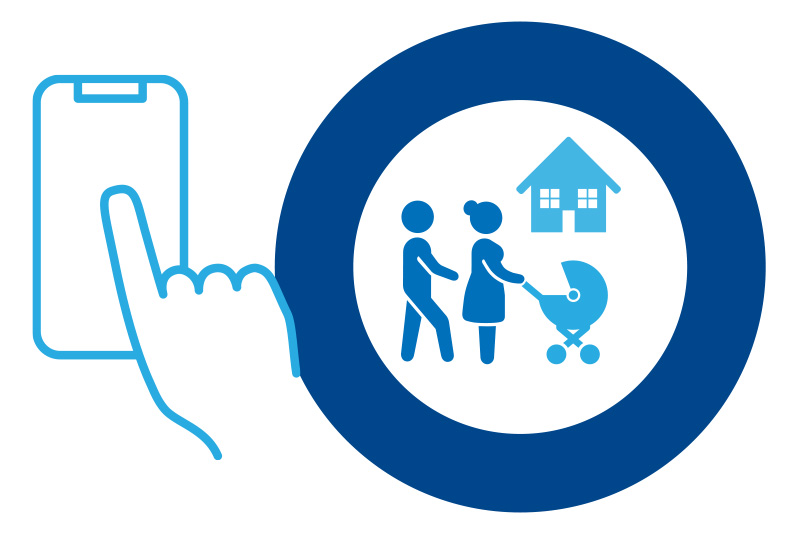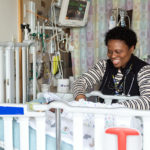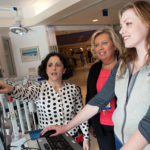Single Ventricle Cardiac Home Monitoring Program empowers families to care for fragile newborns at home

A single ventricle heart condition is a congenital cardiac defect in which only one of the heart’s two ventricles is functioning properly. It is most often corrected with three surgeries: the first, shortly after birth, the second, when a baby is 4 to 6 months old, and the third in the toddler years.
The Single Ventricle Home Monitoring Program (HMP) at Boston Children’s Hospital was founded in 2009 to support children and families through their care journey. Since that time, the program has followed nearly 400 infants, closely monitoring their progress at home during the interstage period — after the first surgery and through the second surgery. It’s a time- and energy-intensive stage for the family, involving tracking daily weights, oxygen saturation measurements, and oral intake. This information — together with weekly phone calls from the HMP’s program coordinator and advanced practice registered nurse Margaret Schroeder, RN, PPCNP-BC — serves as an early warning system for more serious problems and a way to optimize growth during a fragile period.
A safety net for families
The HMP follows all infants with single ventricle defects. This includes ensuring that families have the education and tools they need, such as a pulse oximeter to monitor oxygen saturation levels and an approved scale to capture and trend weights in between frequent clinical follow-up visits. Program staff members — including surgical advanced practiced registered nurses and a registered dietitian — educate families before discharge. They discuss common interstage problems, medical issues to watch for, and review daily tracking of oxygen saturation, weights, and feeds.Families learn how to use the pulse oximeter and scale and log these measurements, either on paper or electronically, through the HMP app.
“Having a point person for families at home is essential during this critical period,” says Schroeder. “The monitoring and the emotional support are also essential tools to help families feel more confident about taking their fragile baby home. The relationship with these families lies at the heart of nursing — helping an infant and their family successfully navigate a chronic condition, both medically and emotionally.”
Schroeder works closely with the inpatient nurses to coordinate teaching and discharge planning for families. The coordinator also provides education to new staff on HMP during the interstage period. She also has extensive contact with the home health care teams, including pediatricians, cardiologists, and the Visiting Nurse Association.
Driving results
The benefits of the HMP can be seen in various outcomes, including improvements in feeding, growth, and weight gain. For example, between 2010 and 2020, 70 percent of the children in the program gained a daily average of 20 grams or more, and 18 percent were at least partially breastfeeding.
“This program continues to be a safe, patient-centered, innovative approach to caring for infants with vulnerable circulation in the home environment,” said Terry Saia, DNP, APRN, CPNP, nurse director of outpatient cardiology in the Cardiovascular Program. “HMP has long been associated with high levels of parental satisfaction, and is actively supported through the pediatrician and cardiology teams as well. Through ongoing patient assessment measures, the program has accurately anticipated the need for urgent care when needed.”
Future goals
The HMP has broader and more specific goals still to target, including:
- More formal data collection practices to guide ongoing program planning.
- Soliciting and implementing feedback insights from families upon exiting the program.
- Building a list of families willing to be resources or supports for future families.
- Researching the many feeding and growing issues that are common in these patients.
- Studying admission trends such as types and length of stay.
“This program has been remarkably successful in establishing a safety net for families, allowing us to improve growth, reduce unnecessary hospitalization, and improve outcomes in this fragile population,” says David Brown, MD, attending cardiologist and Kimbrel Family Chair at Boston Children’s Heart Center.
Learn more about the Single Ventricle Program.
Related Posts :
-

All in the family: Dynamic nursing duos in the Heart Center
Sometimes nursing runs in the family, and at the Boston Children’s Hospital Heart Center, we’re lucky to have ...
-

Boston Children's nurses: Setting the standard for innovation
As clinicians at Boston Children’s Hospital continue to pioneer new therapies for both kids and adults, nurses play a ...
-

Nurses Week 2021: Nurse-led contact tracing team helps reduce the spread of COVID-19
As COVID-19 evolved into a serious threat in March 2020, protecting the health of patients, families, and employees at Boston Children's ...
-

Nurse scientists: Advancing pediatric care through research
Quality nursing care depends on ongoing clinical inquiry — that is, asking questions about current processes and developing the best solutions ...





